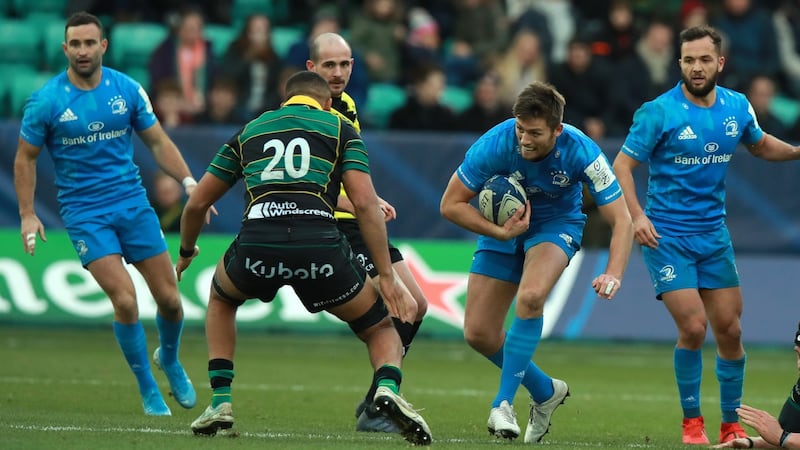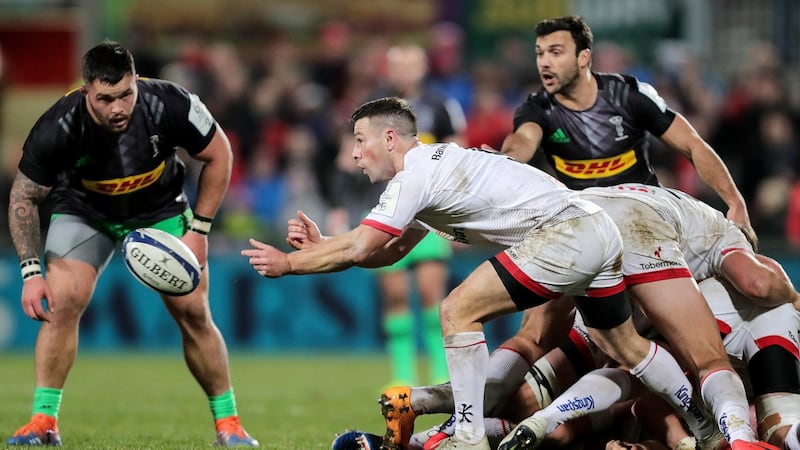A new era, a new World Cup cycle, a new head coach, a new attack coach, a new hooker and, possibly, a new halfback partnership as well. The changing times indeed.
If, as one fervently hopes and is rumoured to be the case, it transpires that Johnny Sexton has damaged his medial ligament in his right knee then the likely scenario is a period of six weeks or so on the sidelines.
In a best case scenario, this would mean a return perhaps a fortnight before the Six Nations opener against Scotland in Dublin on February 1st, namely for Leinster’s final Heineken Champions Cup pool game against Benetton. The odds would then be on Sexton being fit for the Scottish game, and if so he will assuredly start, possibly even as captain.
In a competition such as the Six Nations, Sexton remains the first name on the team sheet. He looks in prime form, and Ireland were as Johnny-dependant as they've ever been in 2019, all the more so as Joey Carbery remains cruelly bedeviled by injuries.
Seemingly having come back too soon in the World Cup after undergoing ankle surgery, the poor lad has played only half a dozen games of rugby since last January, three of them off the bench, and for a grand total of 127 minutes. His frustration is probably only all the more acute given the influence Stephen Larkham is evidently having on JJ Hanrahan.
Carbery is still only 24 and more than most new year’s wishes you’d hope this gifted playmaker has an injury free 2020, for he is still the outhalf most likely to understudy Sexton and ultimately be the heir to the throne.
Return unclear
The date for Carbery’s return remains unclear, but were he to make it back for one or two of the festive derbies and Munster’s final two Euro pool games against Racing and the Ospreys, then he would either be in the match-day squad against Scotland or start.
But as things stand, both Sexton and Carbery are sidelined and, albeit this far out, appear to be significant doubts for the start of the Six Nations. So what would happen then?
On returning from the World Cup, Jack Carty was the next outhalf in line. Perhaps it was the fall-out of the Japan defeat and that World Cup, but Carty's confidence appears to have since waned.
Rather pointedly, Conor Fitzgerald was entrusted to see out Connacht's winning end game against Montpellier and then start in Toulouse. Restored against Gloucester last Saturday, his half-break and offload for the try by John Porch was vintage Carty, but Danny Cipriani's intercept for Gloucester's try was a key moment and Carty was replaced by Fitzgerald almost immediately. Carty nicks a pick-me-up.

By contrast, Ross Byrne has his swagger back. He was dealt a tough hand with a first test start in that pre-World Cup Twickenham horror show, and his defence suffered that day. Byrne doesn't have the same off-the-cuff instinct or short kicking game as Carty, but Byrne can run a game, has that crosskick, is a good goal-kicker and has regularly replaced Sexton at Leinster without them missing a beat.
The way he celebrated his try against Northampton suggested a man on a mission and, significantly, Byrne is now likely to get at least a few big games within that well-oiled Leinster machine. As things stand, that makes him favourite to either start in Sexton’s absence against Scotland, or be in the match-day squad.
However such is the nature of the Irish system, whereby a provincial run can bring the next step to test level close into view, JJ Hanrahan can’t be ruled out either. Finally, at 27, he appears to be in his command of his talents and managing his team. Finally given a chance, he’s certainly never been closer.
Akin to Fitzgerald and Carty at Connacht, Alby Mathewson was entrusted with Munster's endgame against Racing 92 over Conor Murray, which was once unthinkable.
Exaggerated demise
Rumours of Murray’s demise have been greatly exaggerated, and he played well in marshalling Munster’s high tempo game in the first half against Saracens before suffering along with everyone else in the second-half deluge.
But until such time as the domineering, try-scoring world’s best scrumhalf of 2018 returns, especially in this new dawn, Murray’s place has never looked more under pressure since claiming the number nine jersey.
Akin to Carty, Luke McGrath looked to be the next number nine coming back from the World Cup. But no less than Leinster's selections at tighthead and fullback, where the form of Andrew Porter and particularly Jordan Larmour cannot be ignored, the selection of Jamison Gibson-Park (now Irish qualified) ahead of McGrath against Northampton muddies the waters.
Kieran Marmion’s contract extension was a statement of intent but he is sidelined again, whereas Caolin Blade’s stock rises, and his threat off the base is unrivalled.

Meantime, John Cooney is the form scrumhalf in the country. Ulster's match-winner in their three European games so far, he could come into the Six Nations on the crest of the biggest wave. His influence is so profound that sometimes you'd hardly notice who Ulster's outhalf is. Cooney is almost French-like, and his regular goal-kicking is another string to his bow. He's 29, but so be it. Like Hanrahan, not every player travels the quick road to the summit.
All things being equal, Murray-Sexton still seems the likeliest combination, with Cooney and Byrne on the bench. We shall see.
But where once there was certainty, now there is fluidity. Where once the Murray-Sexton axis was pretty much cast in stone now, due to a combination of factors, for the first time since the 2011 World Cup, that is no longer case.















